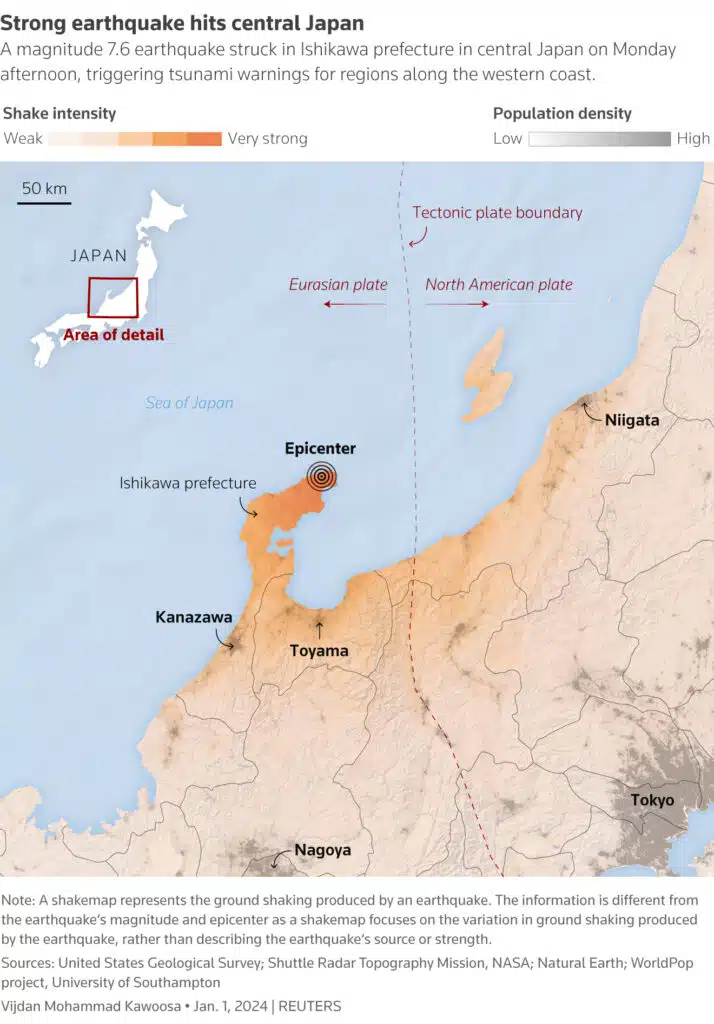Japan Hit by Strong Earthquake – On Monday, central Japan was jolted by a formidable earthquake, claiming at least one life and causing severe destruction.
The earthquake demolished buildings, disrupted power for tens of thousands of households, and urged coastal residents to seek safety on higher ground.
Measuring at a preliminary magnitude of 7.6, the quake generated approximately 1-meter waves along Japan’s western coastline and adjacent areas of South Korea. Authorities cautioned about the potential for even more giant waves in the aftermath.
The Japan Meteorological Agency (JMA) issued tsunami alerts covering Ishikawa, Niigata, and Toyama prefectures. Specifically, Ishikawa faced a significant tsunami warning, the first of its magnitude since the devastating March 2011 earthquake and Tsunami in northeastern Japan.
However, this warning was de-escalated and eventually shifted to an advisory status, indicating an expectation of waves up to 1 meter (3 feet) high.
According to the U.S. Geological Survey, this earthquake marked the most powerful tremor in the region in over four decades.
Russia and North Korea also issued tsunami warnings for specific regions.
Government spokesperson Yoshimasa Hayashi informed reporters of the destructive aftermath: houses were razed, fires erupted, and military personnel were deployed to aid in rescue operations.
Tragically, a senior man lost his life due to a building collapse in Shika Town, Ishikawa, as reported by local police sources cited by broadcaster NTV.
Describing the chaos, Jonny Wu, a Taiwanese tourist on a skiing holiday in the nearby Nagano prefecture, recounted to Reuters, “The snow fell from the electric wires and roofs, causing the cars to shake, leading to widespread panic.”
Japanese Prime Minister Fumio Kishida informed reporters that despite the challenges posed by blocked roads, he had directed search and rescue teams to exert maximum effort in saving lives within the quake-affected areas.
Anticipating further seismic activity in the region, JMA official Toshihiro Shimoyama cautioned that additional strong tremors might occur over the upcoming days.
By Monday night, the government’s evacuation orders affected over 97,000 individuals across nine prefectures on Honshu’s western coast.
In a post-quake address to the media, Kishida advised residents to brace themselves for potential subsequent disasters, urging those in tsunami-prone areas to evacuate promptly: “I urge people in areas where tsunamis are expected to evacuate as soon as possible.”

Following the catastrophe, the Imperial Household Agency declared the cancellation of Emperor Naruhito and Empress Masako’s scheduled New Year appearance on Tuesday.
After the earthquake, television screens lit up with a bold yellow message: “Tsunami! Evacuate!” The urgent alert targeted residents in some coastal regions, urging them to evacuate immediately.
Local media footage captured a building crumbling into a cloud of dust in Suzu city, while in Wajima, a significant crack appeared on the road, causing distress among parents trying to ensure the safety of their children.
Wajima, a town known for its lacquerware and home to approximately 30,000 people, witnessed reports of around 30 collapsed buildings, with fires engulfing several structures.
The quake’s tremors rattled buildings even in Tokyo, located some 500 km away on the opposite coast.
As of late Monday, nearly 32,000 households in Ishikawa prefecture were still grappling with power outages, with temperatures expected to plunge to near freezing overnight in certain areas, as reported by utility provider Hokuriku Electric Power (9505.T).
In neighboring Niigata prefecture, Tohoku Electric Power (9506.T) noted that 700 households remained without power.
Telecom companies reported phone and internet disruptions in specific regions.
The quake disrupted 40 train lines and two high-speed rail services, halting operations. Additionally, six expressways shut down, and a runway crack forced the closure of an airport in Ishikawa, according to transport authorities.
Japanese airlines reacted swiftly: ANA (9202.T) redirected planes bound for Toyama and Ishikawa, while Japan Airlines (9201.T) canceled most of its services to the Niigata and Ishikawa areas.

The earthquake arrives at a critical juncture for Japan’s nuclear sector, grappling with local resistance following the 2011 Fukushima disaster, which resulted from an earthquake and tsunami, claiming nearly 20,000 lives and devastating entire communities.
Recently, Japan lifted the operational ban on the Kashiwazaki-Kariwa nuclear plant, the world’s largest, offline since the 2011 tsunami.
The Nuclear Regulation Authority confirmed no abnormalities at nuclear facilities along the Sea of Japan, including Kansai Electric Power’s (9503.T) Ohi and Takahama plants in Fukui Prefecture, housing five active reactors.
Fortunately, Hokuriku’s Shika plant in Ishikawa, closest to the quake’s epicenter, had already shut down its two reactors for routine checks and remained unaffected by the tremor, as stated by the agency.
The earthquake struck during Japan’s Jan. 1 public holiday, when millions traditionally visit temples to usher in the new year.
In Kanazawa, a renowned tourist spot in Ishikawa, images depicted a shattered stone gate strewn at a shrine’s entrance while concerned worshippers observed.
Ayako Daikai, a Kanazawa resident, recounted evacuating with her husband and two children to a nearby elementary school immediately after the quake.
She mentioned that classrooms, stairwells, hallways, and the gymnasium were filled with evacuees and, when contacted by Reuters, expressed uncertainty about when they would return home.
 Twitter
Twitter Facebook
Facebook